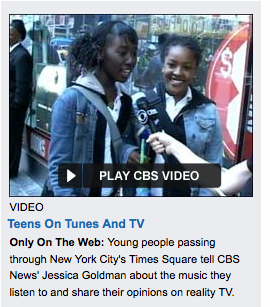Notes on Cultural Analytics Seminar, December 16-17, 2009, Calit2, San Diego, by Eduardo Navas
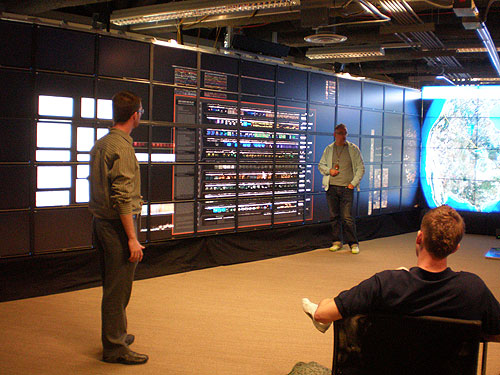
Jeremy Douglass (left) and Lev Manovich (far right) demonstrate how to analyze data on the Hyper Wall at Calit2.
The Cultural Analytics seminar took place at Calit2 on December 16 and 17 of 2009. The event brought together researchers and students from Bergen University and University of California San Diego. The two day event consisted of research presentations and demos of software tools.
Part One of Hyper Wall Demonstration during Cultural Analytics Seminar at Calit2, San Diego, December 16-17, 2009. Introduction to principles of Cultural Analytics.
I will not spend much time in this entry defining Cultural Analytics. This subject has been well covered by excellent blogs such as Open Reflections. For this reason, at the end of this entry I include a number of links to resources that focus on Cultural Analytics. Instead, I will briefly share what I believe Cultural Analytics offers to researchers in the humanities.
Part Two of Hyper Wall Demonstration during Cultural Analytics Seminar at Calit2, San Diego, December 16-17, 2009. Analysis of Vertov’s motion in scenes from Man with a Movie Camera.
This emerging field can be defined as a hybrid practice that utilizes tools of quantitative analysis often found in the hard sciences for the enhancing of qualitative analysis in the humanities. The official definition of the term follows:
Cultural analytics refers to a range of quantitive and analytical methodologies drawn from the natural and social sciences for the study of aesthetics, cultural artifacts and cultural change. The methods include data visualization techniques, the statistical analysis of large data sets, the use of image processing software to extract data from still and moving video, and so forth. Despite its use of empirical methodologies, the goals of cultural analytics generally align with those of the humanities.
One thing that separates the humanities from the hard sciences is the emphasis of qualitative over quantitative analysis. In very general terms qualitative analysis is often used to evaluate the how and why of particular case studies, while quantitative analysis focuses on patterns and trends, that may not always be concerned with social or political implications.
Part Three of Hyper Wall Demonstration during Cultural Analytics Seminar at Calit2, San Diego, December 16-17, 2009. Jeremy Douglass analyzes comic books.
What Cultural Analytics is doing, in my view, is bringing together qualitative and quantitative analysis for the interests of the humanities. In a way Cultural Analytics could be seen as a bridge between specialized fields that in the past have not always communicated well.
Consequently, when new ground is being explored, questions of purpose are bound to emerge, which is exactly what happened during seminar conversations. As the videos that accompany this brief entry will demonstrate, the real challenge is for researchers in the humanities to engage not only with Cultural Analytics tools and envision how such tools can enhance their practice, but to actually embrace new philosophical approaches that blur the lines between the hard sciences and the humanities.
Part Four of Hyper Wall Demonstration during Cultural Analytics Seminar at Calit2, San Diego, December 16-17, 2009. Cicero Da Silva explains his collaborative project, Macro.
To be specific on the possibilities that Cultural Analytics offers to the humanities, I will cite two demonstrations by Lev Manovich and Jeremy Douglass.

Lev Manovich at one point presented Hamlet by William Shakespeare in its entirety on Calit2’s Hyper Wall, which consists of several screens that enable users to navigate data at a very high resolution.
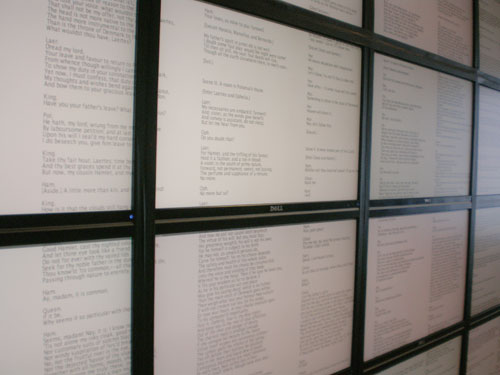
When seeing the entire text at once, one is likely to realize that this methodology is more like mapping. To this effect, soon after, we were shown a version of the text in which Manovich had isolated the repetition of certain words throughout the literary work.
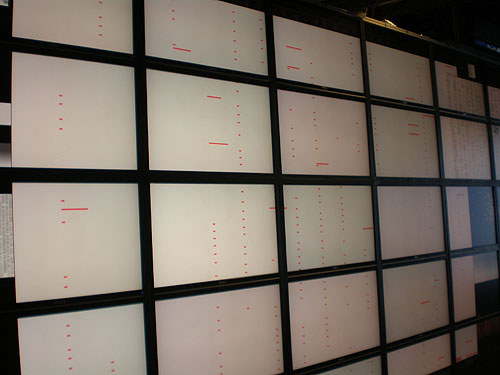
This approach could be used by a literature scholar to study certain linguistic strategies, such as sentence structure, by an author. Let’s take this a step further and say that it has been agreed that a contemporary author is influenced by a canonical writer. How this supposed influence takes effect can be evaluated by studying certain patterns of sentences from both authors by isolating parts of literary texts for direct comparison. One could then evaluate if the supposed influence is formal, conceptual or both: perhaps the contemporary author might make ideological references that are clearly linked to the canonical author, but which are not necessarily influenced at a formal level; or it could be the other way around, or both. In this case, quantitative and qualitative analysis are combined to evaluate a case study. In other words, pattern comparison is used to understand the similarities and differences between two or more works of literature.
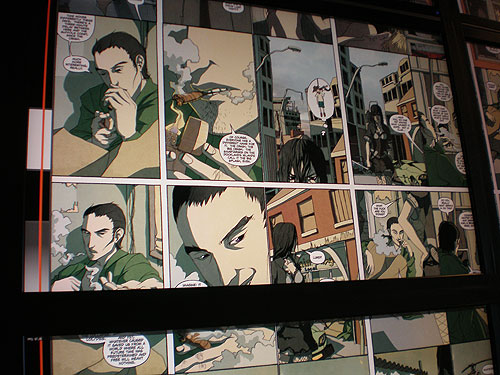
To this effect, Jeremy Douglass’s presentation of a comic book is important. He explained how by seeing an entire publication of a comic book story one can study how certain patterns in the narrative come to define the aesthetics for the reader.
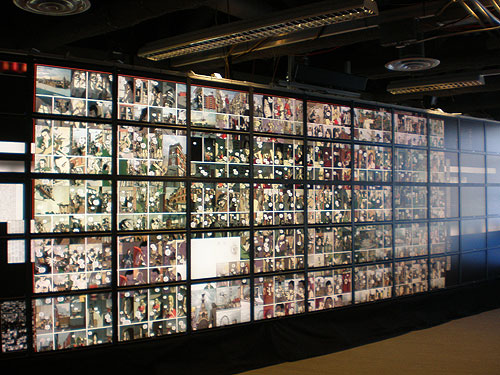
While the reader may be able to experience the story in time, by actually reading it, the visualization of the comic book in grid-like fashion–as a structural map–allows the researcher to apply analysis of patterns and trends that may be more common in flows of networks to an actual narrative. Again, in this case we find quantitative and qualitative analysis complementing each other.
As noted at the end of the article “Culture is Data” (also provided below) from Open Reflections, it appears that Manovich is at times understood to argue that one should privilege quantitative over qualitative analysis. This proposition implies an either or mentality by certain researchers that needs to be reevaluated. Janneke Adema explains his answer better than I ever could:
But, on the other hand, won’t we loose a sense of meaning if we analyze culture like a thing? Manovich argues that this is of course a complementary method, we should not throw away our other ways of establishing meaning. It is a way of expanding them. And it is also an important expansion, for how is one going to ask about the meaning of large datasets? We need to combine the traditionally [sic]humanities approach of interpretation with digital techniques to find out more. And again, meaning is not the only thing to look at. It is also about creating an experience. Patterns are the new real of our society.
The most important thing to understand when evaluating the videos available with this entry is that one need not have a hyper wall to do research with Cultural Analytics methodologies; many of the tools can run on a personal computer. It’s more about adopting an attitude and willingness to do research by way of combining quantitative and qualitative analysis. At the moment I am evaluating the implementation of Cultural Analytics in my research on Remix.
References worth perusing:
Cultural Analytics Seminar Schedule: http://lab.softwarestudies.com/2009/11/cultural-analytics-seminar-software.html
Software Studies, Website: http://lab.softwarestudies.com/2008/09/cultural-analytics.html
“Culture is Data,” article: http://openreflections.wordpress.com/2009/05/23/culture-is-data/
Culture Vis, Website: http://culturevis.com/cultural_analytics.html
“Cultural Analytics,” Wikipedia entry: http://en.wikipedia.org/wiki/Cultural_analytics
“The Next Big Thing in Humanities, Arts and Social Science Computing: Cultural Analytics,” article: http://www.hpcwire.com/features/The_Next_Big_Thing_in_Humanities_Arts_and_Social_Science_Computing_Cultural_Analytics.html
“Lev Manovich: Studying Culture With Search Algorithms,” article: http://networkcultures.org/wpmu/query/tag/cultural-analytics/
“Cultural Analytics: a new field that combines arts, media and IT,” article: http://knowledge.smu.edu.sg/article.cfm?articleid=1201

